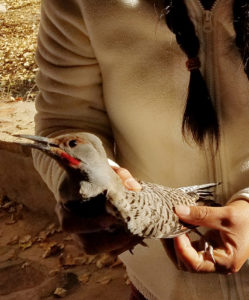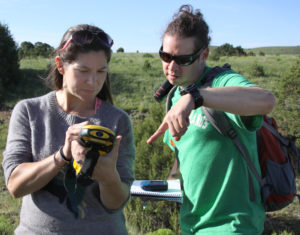
New Mexico Highlands University at Rio Mora National Wildlife Refuge provides opportunities for students and faculty to learn and teach in the majestic setting of the Mora Valley, in north central New Mexico. Located where the shortgrass prairie transitions to the high mountain landscape of the Sangre de Cristo mountains, Rio Mora NWR is a unique setting for discovering and understanding the natural and cultural processes that have shaped and continue to shape this region.
The refuge is a mosaic of rocky bluffs, grassland expanses, piñon-juniper-ponderosa pine woodlands, and wetlands, dotted with Native American sites and the ruins of historic pioneer homesteads. Wildlife, including deer, elk, mountain lions, bobcats, bear, and beaver, along with a variety of raptors, grassland, and wetland bird species make their home on the refuge. A herd of bison, owned by the Pueblo of Pojoaque, roam the grasslands.
The refuge was established in 2012 through the donation of the Wind River Ranch by the Thaw Charitable Trust. The refuge continues the Wind River Ranch’s mission of education and outreach in conservation and restoration. It is home to a unique management and education partnership among the U. S. Fish and Wildlife Service, the Denver Zoo, New Mexico Highlands University, and the Pueblo of Pojoaque.
 New Mexico Highlands University students study at the refuge to learn and gain practical knowledge in field data collection across a myriad of disciplines, including field biology, water resources, forestry, and hydrology, mapping, and environmental geology. In addition to a natural, outdoor classroom, learning facilities include a classroom and a bunkhouse, with adjacent camping. Classes often participate in Rio Mora NWR’s very active ecological restoration program. The refuge has become a showcase for techniques in riparian and arroyo restoration and rehabilitation.
New Mexico Highlands University students study at the refuge to learn and gain practical knowledge in field data collection across a myriad of disciplines, including field biology, water resources, forestry, and hydrology, mapping, and environmental geology. In addition to a natural, outdoor classroom, learning facilities include a classroom and a bunkhouse, with adjacent camping. Classes often participate in Rio Mora NWR’s very active ecological restoration program. The refuge has become a showcase for techniques in riparian and arroyo restoration and rehabilitation.
Rio Mora NWR has also hosted NMHU faculty, graduate, and undergraduate researchers studying a diverse array of topics such as invasive bullfrog and crayfish interactions with native fish and amphibians, grassland bird diversity, genetics of native leopard frog populations, native plant germination, and the effectiveness of arroyo restoration techniques.
Rio Mora Five year Report 2018: click here
For more information about NMHU activities at Rio Mora NWR, or to arrange an individual or class visit to the refuge, contact:
Joseph P. Zebrowski, M.Sc.
NMHU – Rio Mora NWR Liaison
Natural Resources Management Department
New Mexico Highlands University
Box 9000
Las Vegas, NM 87701
505-426-2146
jpzebrowski@nmhu.edu
For more information about the refuge and its programs, visit the U. S. Fish and Wildlife Servive Rio Mora NWR website at https://www.fws.gov/refuge/rio_mora/ and the Denver Zoological Foundation at Rio Mora NWR website at http://windriverranch.org/
